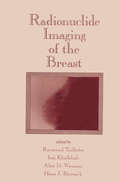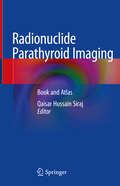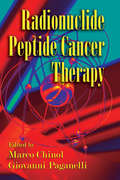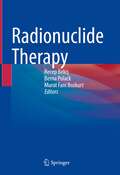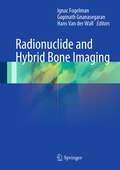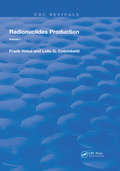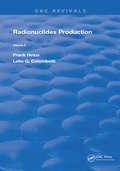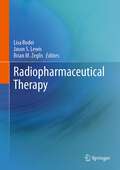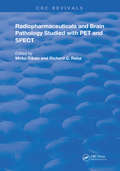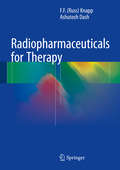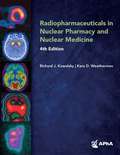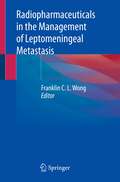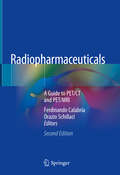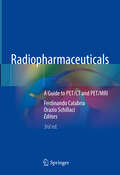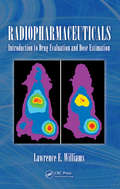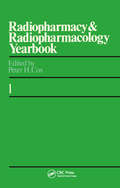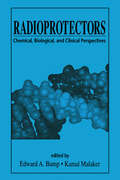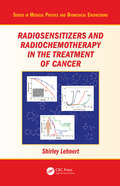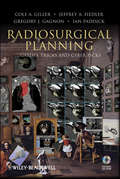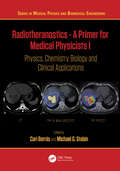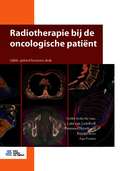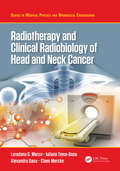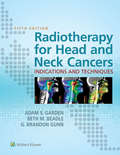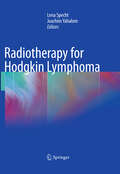- Table View
- List View
Radionuclide Imaging of the Breast
by Raymond TailleferDemonstrating the role of nuclear medicine as a complementary technique to mammography and other imaging modalities for the diagnosis of breast cancer, Radionuclide Imaging of the Breast provides a comprehensive overview of scintimammography-an accurate, safe, and noninvasive imaging method for the evaluation of breast lesions and malignancies. Reveals the encouraging results of multicenter clinical trials in the U.S. and Canada using 99mTc sestamibi breast imaging for the diagnosis of primary breast carcinoma! Addressing nonsurgical sampling of nonpalpable breast lesions as an effective means of providing diagnostic and prognostic information, Radionuclide Imaging of the Breastdiscusses increasing the diagnostic value of mammography and its widespread use examines the reliability of FDG-PET and FDG-SPECT in detecting lymph node involvement and distant metastases reviews breast cancer imaging with monoclonal antibodies, including murine and bioengineered antibodies compares the benefits and limitations of Thallium-20l to 99mTc-sestamibi breast imaging in evaluating suspected malignancy assesses the clinical impact of scintimammography as an adjunctive test to mammography to improve the dependability of diagnoses considers the possibility of replacing axillary lymph node dissection in patients with small breast cancers with the sentinel node approach clarifies the importance of surgery in the multimodality treatment of breast cancer elucidates pathologic difficulties for breast cancer diagnosis and more! Radionuclide Imaging of the Breast serves as an essential reference for nuclear medicine physicians, radiologists, breast surgeons, medical and surgical oncologists, gynecologists, pathologists, internists, and primary care physicians.
Radionuclide Parathyroid Imaging: Book and Atlas
by Qaisar Hussain SirajThis atlas, compiled by experienced specialists in the field, is designed as a ready reference on the use of parathyroid scintigraphy in patients with hyperparathyroidism, both for the localisation of parathyroid pathology and as an aid to surgery. The introductory chapters review the basic core knowledge on the subject. Eighty case reviews are then presented, covering gamma camera planar imaging, SPECT, hybrid SPECT-CT, and also PET-CT. In total, 240 illustrations are included, comprising 160 grey-scale photos depicting nuclear medicine and CT images and 80 dual-modality fusion colour photos. This compilation of illustrative clinical cases will greatly assist clinicians and imaging specialists in image interpretation in different settings. The images replicate normal conventional formats used for routine reporting and hence facilitate fast and reliable diagnosis. Each of the case reviews includes documentation of the procedure, findings, and conclusions with relevant commentary. Surgeons, nuclear medicine physicians, and radiologists will find the Radionuclide Parathyroid Imaging: Book and Atlas to be a valuable practical tool and learning aid.
Radionuclide Peptide Cancer Therapy
by Marco Chinol Giovanni PaganelliOffering lower toxicity and higher accuracy than conventional therapies, this source offers illustrative coverage of this new method to treat tumors associated with brain, breast, lung, and neuroendocrine cancers. Accompanied by a CD offering color images, radiolabeling procedures, and tips on radiopharmceutical administration, this source will off
Radionuclide Therapy
by Recep Bekiş Berna Polack Murat Fani BozkurtThe main purpose of this book is to create a reference for the indications, contraindications, patient selection, treatment practice, treatment side effect management, and follow-up of radionuclide treatments. Besides standard methods such as surgery, chemotherapy, radiotherapy, and hormone therapy, newly developed biological treatments, targeted treatments, personalized treatments, external beam radiotherapy, and targeted radionuclide treatments have begun to take their place in professional practice. Nuclear medicine, in addition to its role as a tracer of cancer, also assumes the role of treating with radioactive molecules directed to the cancer it traces. These traceable next-generation radionuclide treatments, whose efficacy and reliability have been proven and where diagnosis, treatment, and follow-up are carried out together, are increasingly included in oncology practice together with the new developed radiopharmaceuticals, ensuring a high rate of damage to cancer cells while protecting the surrounding normal tissues. Molecular cancer treatment will become more effective with individualized next-generation traceable radionuclide treatments, which will be shaped by genetic studies in the future. Radionuclide treatments for many cancer types and benign diseases are presented by experienced nuclear medicine experts in the light of their own experience and case studies, while systemic treatments in common cancer types and side effect management of these treatments are summarized by medical oncologists. This book will be of interest to nuclear medicine physicians as well as oncologists.
Radionuclide and Hybrid Bone Imaging
by Gopinath Gnanasegaran Ignac Fogelman Hans Van WallThis book, written by authors with national and international reputations in the field, covers all aspects of radionuclide and hybrid bone imaging. Introductory sections present the basic science and consider the current status and limitations of conventional radiological techniques. The underlying principles of PET-CT and SPECT-CT are carefully explained, and the value of different PET and SPECT tracers, assessed. The role of single- and dual-modality approaches in the imaging of benign bone diseases and malignancies is then discussed in detail in a series of well-illustrated chapters. The pathologies addressed include metabolic bone disease, arthritis, bone and joint infections, primary bone and soft tissue tumors, and metastases from breast and prostate cancer. A further section considers the role of bone scintigraphy in the pediatric patient, and the closing chapters focus on miscellaneous subjects, including bone densitometry and radionuclide targeted therapy.
Radionuclides Production: Volume 1 (Routledge Revivals #1)
by Frank HelusFirst Published in 1983, this book offers a full, comprehensive guide into the production of radioactive nuclides. Carefully compiled and filled with a vast repertoire of notes, diagrams, and references this book serves as a useful reference for Students of Radiology, and other practitioners in their respective fields.
Radionuclides Production: Volume 2 (Routledge Revivals #2)
by Frank HelusFirst Published in 1983, this book offers a full, comprehensive guide into the production of radioactive nuclides. Carefully compiled and filled with a vast repertoire of notes, diagrams, and references this book serves as a useful reference for Students of Radiology, and other practitioners in their respective fields.
Radiopharmaceutical Therapy
by Jason S. Lewis Brian M. Zeglis Lisa BodeiThis book covers foundational topics in the emerging field of radiopharmaceutical therapy. It is divided into three sections: fundamentals, deeper dives, and special topics. In the first section, the authors examine the field from a bird’s-eye view, covering topics including the history of radiopharmaceutical therapy, the radiobiology of radiopharmaceutical therapy, and the radiopharmaceutical chemistry of both metallic and non-metallic radionuclides. The second section provides a more in-depth look at specific radiotherapeutics. Chapters include broader discussions of the different platforms for radiopharmaceutical therapy as well as more focused case studies covering individual radiotherapeutics. The third and final section explores a number of areas for further study, including medical physics, artificial intelligence, in vivo pretargeting, theranostic imaging, and the regulatory review process for radiotherapeutics.This book is the first of its kind and is useful for a broad audience of scientists, researchers, physicians, and students across a range of fields, including biochemistry, cancer biology, nuclear medicine, radiology, and radiation oncology.
Radiopharmaceuticals and Brain Pathophysiology Studied with Pet and Spect: Studied With Pet And Spect (Routledge Revivals)
by M. Diksic Richard C. RebaFirst published in 1991, this book covers three major areas essential to in vivo biochemical studies with PET and SPECT: synthesis of radiopharmaceuticals, biological modeling, and clinical applications. The book emphasizes advances in the synthesis of radiopharmaceuticals used in PET and SPECT studies of brain flow and oxidatative metabolism, in addition to biological modeling. The most widely used 2-deoxyglucose/2-fluorodeoxyglucose models are discussed, as well as models used in the quantitation of brain receptors. Other topics include a possible model for converting 6-[18F] fluorodopa images into the quantitative rate of dopamine synthesis, evaluations of technetium- and iodine-labeled blood flow tracers, and possibilities for using SPECT to measure other pathophysiological variables. This book will be a valuable reference source to students and specialists interested in these in vivo measurements.
Radiopharmaceuticals for Therapy
by F. F. Russ Knapp Ashutosh DashThis book provides detailed information on therapeutic radiopharmaceuticals and discusses emerging technologies which have potential for broad clinical implementation. Recent advances in molecular biology, radiopharmaceutical chemistry and radioisotope production have stimulated a new era for the use of radiopharmaceuticals for targeted radionuclide therapy (TRT). Emerging clinical trials include use of peptides and monoclonal antibodies radiolabeled with therapeutic radionuclides for cancer therapy. In addition, small molecules are used for the treatment of chronic diseases such as metastatic bone pain palliation and radiation synovectomy of inflammatory joints. In the interventional arena, therapy of primary and metastatic liver cancer and arterial restenosis following angioplasty of both the coronary and peripheral arteries are being explored. Reactor and accelerator production of therapeutic radioisotopes is also integrated into these discussions. The development and use of radiopharmaceutical targeting characteristics required for treatment of specific disease processes and how these are implemented for radiopharmaceutical design strategies are also described. Radiopharmaceuticals for Therapy will benefit audiences in nuclear medicine and radionuclide therapy and will thus prove an invaluable source of up-to-date information for students, radiopharmaceutical scientists and professionals working in the radiopharmacy and nuclear medicine specialties.
Radiopharmaceuticals in Nuclear Pharmacy and Nuclear Medicine
by Richard J. Kowalsky Kara D. WeathermanAs with previous editions of this textbook, Radiopharmaceuticals in Nuclear Pharmacy and Nuclear Medicine, Fourth Edition, provides a comprehensive introduction to radiopharmaceuticals and their applications in nuclear medicine. With the increasing emphasis on PET and the expanding role of theranostics, the nuclear medicine community continues to grow as evidenced by the development of several new radiopharmaceuticals and technologies for diagnostic and therapeutic applications in recent years. The book is intended for use in courses taught in the disciplines of nuclear pharmacy, nuclear medicine technology, and nuclear medicine. The chapter topics are of moderate depth and breadth and are referenced to the primary literature. As such, this textbook has become a useful resource for professional practitioners in these disciplines and for those preparing for specialty board examination.
Radiopharmaceuticals in the Management of Leptomeningeal Metastasis
by Franklin C. L. WongThis book reviews the current clinical practice of leptomeningeal metastasis (LM) diagnosis and treatment, which is predominately by intrathecal chemotherapy and/or in combination with external beam radiotherapy. LM is a refractory lethal complication of many human malignancies when neoplastic cells grow in the meninges. The use of penetrating emissions from radionuclides has the advantages of visualizing cerebrospinal fluid (CSF) flow and ablating meninges at shallow depths and has been used to diagnose CSF flow anomalies and to treat LM. The scientific bases of using radionuclides inside human CSF and ablating LM will be discussed within the text, with results from established and completed clinical trials to explore optimal use of radionuclides to diagnose and treat LM. Many limitations of current practices of treating LM are also discussed, as well as potential avenues of overcoming these limitations. This book is an ideal guide for clinical researchers in the practice of treating leptomeningeal metastasis including radiologists, neurologists, oncologists and radiotherapists as well as their associates.
Radiopharmaceuticals: A Guide to PET/CT and PET/MRI
by Ferdinando Calabria Orazio SchillaciThis book provides a rapid and concise guide to PET (PET/CT and PET/MRI) molecular imaging, concentrating extensive information on PET radiopharmaceuticals in a single volume.The book reflects the rapid development of several PET tracers over the last decade, as a result of which the “traditional” PET/CT with 18F-FDG, the “cornerstone” of PET imaging, is now only one of several available options, which use different tracers for different diseases. For the same reason, PET imaging is no longer limited to the field of oncology. In the editors’ experience, students in medicine and residents in nuclear medicine and radiology have limited access to scientific papers concerning novel PET tracers. Moreover, these papers generally focus on a single PET radiopharmaceutical. With approx. 20 radiopharmaceuticals explained in detail and a wealth of images and clinical cases, the book represents a versatile, comprehensive and practice-oriented guide to PET imaging, pursuing a unique and novel approach to the clinical role of PET tracers. The book’s didactic nature also makes it an invaluable tool for residents in nuclear medicine and radiology, as well as for radiographers and clinicians in radiotherapy, oncology, hematology, cardiology and neurology.
Radiopharmaceuticals: A Guide to PET/CT and PET/MRI
by Ferdinando Calabria Orazio SchillaciThe book is a practical and concise guide to PET tracers actually useful for PET/CT and PET/MR imaging.Gaining knowledge on radiopharmaceuticals is often difficult, since their features can be only found in single original journal articles.This book aims to present to the reader, in one single place, clinical features, indications and future trends for PET imaging with a large amount of tracers. While 18F-FDG still remains the miliar stone across PET tracer, new emerging fields of application of PET imaging are consolidated by using disease specific tracers in specific clinical settings.Each chapter is focused on a single tracer or on a group of similar tracers. The basis and structure of the chapters is the same throughout the book: essential information on synthesis and in vivo distribution of a tracer, clinical cases, eloquently showing clinical indications and usefulness, future trends, scientific literature. Featuring over 30 radiopharmaceuticals and 240 clinical cases, the 3rd edition has been enriched with additional chapters on the clinical indications and/or common pitfalls for 18F-fluciclovine PET/CT in prostate cancer imaging and for 18F-MISO in PET tumor hypoxia imaging, as well as applications and future directions for 18F-FES and other PET radiopharmaceuticals.All other chapters of the previous edition have been revised and updated, in particular those chapters covering 18F-DOPA, radiolabeled choline, and 18F-NAF, due to emerging clinical applications for these tracers, 18F-choline for imaging of parathyroid adenoma and 18F-DOPA for restaging of medullary thyroid cancer. The book will be an invaluable guide for professionals and residents in nuclear medicine, radiology, oncology.
Radiopharmaceuticals: Introduction to Drug Evaluation and Dose Estimation
by Ph.D., Lawerence WilliamsNanoengineering, energized by the desire to find specific targeting agents, is leading to dramatic acceleration in novel drug design. However, in this flurry of activity, some issues may be overlooked. This is especially true in the area of determining dosage and evaluating the effects of multiple agents designed to target more than one site of met
Radiopharmacy and Radiopharmacology Yearbook
by Peter H. Cox Christine M. KingFirst Published in 1985, this yearbook is an annual reference providing a concise source of information concerning recent developments in the radiopharmaceutical sciences.
Radioprotectors: Chemical, Biological, and Clinical Perspectives
by Edward A. Bump Kamal MalakerIt is essential to minimize damage to normal tissues during radiation therapy and many strategies have been employed in finding the best methods for radioprotection. This book integrates chemical, biological, and clinical perspectives on these strategies and developments, providing a comprehensive treatise. It emphasizes new concepts in radioprotection, aiming to inspire further basic science and clinical progress in radioprotector research. Radioprotectors: Chemical, Biological, and Clinical Perspectives includes the following topics:Early research on radioprotectorsWR-2721, an aminothiol prodrug, as a radioprotectorNew results with naturally occurring thiolsNitroxides as effective radioprotectors in vitro and in vivoRadioprotection observed with radical scavengers or antioxidantsBone marrow radioprotection with cytokines and biological modifiersMultiple mechanisms of altering radiation response by eicosanoidsVascular response to radiation and the importance of vascular damage to normal tissue Modifiers of radiation-induced apoptosisSurvey of clinical trials with radioprotectorsRadiation biologists and oncologists, cancer researchers, and toxicologists will benefit from the findings discussed and strategies for future research.
Radiosensitizers and Radiochemotherapy in the Treatment of Cancer (Series in Medical Physics and Biomedical Engineering)
by Shirley LehnertRadiosensitizers and Radiochemotherapy in the Treatment of Cancer catalogs and describes the mechanism of action for entities characterized as radiosensitizers. Developments in the biological and physical sciences have introduced new radiosensitizers and defined novel targets for radiosensitization. As a result, a book about radiosensitization must
Radiosurgical Planning
by Cole A. Giller Jeffrey A. Fiedler Gregory J. Gagnon Ian PaddickA self-contained treatment of surgical planning forbeginners and a compendium of tips and tricks for expertsRadiosurgery is a complex procedure requiring the physician to construct a radiosurgical plan, i.e., a map that tells the radiation device exactly where to aim the beams of radiation. While there are plenty of books and articles describing radiosurgery's efficacy, until now there has been no instruction manual for those who wish to learn the secrets of its execution in common practice.Radiosurgical Planning: Gamma Tricks and Cyber Picks is the first self-contained instruction manual for both beginners and experts, teaching the art and science of radiosurgery with an emphasis on the use of the Gamma Knife and the CyberKnife for treatment oflesions in both the brain and body.The authors-who together hold more than sixty years of experience in the field of radiosurgery-begin with a discussion of the general principles of radiosurgical planning, radiosurgical algorithms, and an overview of practical first steps for beginners. Next, they offer an extensive compendium of practical tricks and picks for more seasoned experts. Included is a bonus CD-ROM that contains exercise files that can be loaded directly into the Gamma Knife planning software, as well as stand-alone simulation software that allows readers to practice radiosurgical planning without the necessity for a real radiosurgical device.Radiosurgical Planning: Gamma Tricks and Cyber Picks is an indispensable resource for physicians, medical physicists, dosimetrists, neurosurgery and radiation oncology residents, and anyone involved in the expanding field of radiosurgery.
Radiotheranostics - A Primer for Medical Physicists I: Physics, Chemistry, Biology and Clinical Applications (ISSN)
by Cari Borrás Michael G. StabinThis book covers scientific, clinical, and educational aspects of radiotheranostics in cancer control. Setting the framework, the first volume defines radiotheranostics and describes the history of radionuclide therapy and theranostics, and the biology of cancer. It examines the clinical applications of unconjugated radionuclides, such as ¹³¹I and ²²³Ra, and of radionuclide-conjugated cancer-specific vectors: peptides, small molecules, antibodies, and nanoparticles; introduces clinical trials and drug development; and reviews epidemiological studies and the adverse effects of radionuclide therapy – both radiation injuries and chemical toxicity. It presents the chemistry and physics of radionuclide production, discusses radioactivity measurements and traceability, and addresses important instrumentation aspects: calibration, quantitative imaging, and quality control. Volume I concludes with guidance on the education, training, and competence of a radiotheranostic multidisciplinary team and summarizes the principal physics characteristics of theranostics today – including many to be expanded in the second volume – while offering a glimpse into tomorrow. This volume provides the foundations for the more advanced second volume, which explores dosimetric and radiation safety, aiming to empower medical physicists and demonstrate to the cancer community how to improve cancer control and yield increased patient survival times.It will be a valuable reference for medical and health physicists with basic knowledge of nuclear medicine.Key Features• Provides a comprehensive introduction to the topic, presenting readers with thorough treatment in a cohesive two-volume book.• Presents a rigorous approach while remaining accessible to students and trainees in the field.• Contains consistent and extensive references to allow readers to delve deeper into the subject.
Radiotherapie bij de oncologische patiënt (Medische beeldvorming en radiotherapie)
by Age Froma Laila Van Zadelhoff Pieternel Thysebaert Ronald KeusDit boek beschrijft de mogelijke bestralingsindicaties en -technieken en schetst een beeld van de totale zorg bij de oncologische patiënt op een afdeling radiotherapie. Na een inleidend hoofdstuk over de stralingsbehandeling wordt de bestraling van tumoren in specifieke gebieden besproken. Aan de orde komen: mammacarcinoom, gynaecologische tumoren, urologische tumoren, tumoren van de tractus digestivus, longtumoren, hoofd-halstumoren, neurologische tumoren, hematologische ziektebeelden, sarcomen, huidtumoren, tumoren bij kinderen, en palliatieve radiotherapie.Radiotherapie bij de oncologische patiënt maakt deel uit van de serie Medische beeldvorming en radiotherapie. Behalve als leerboek voor MBB'ers (medisch beeldvormend en bestralingsdeskundigen) is het ook als naslagwerk bij uitstek geschikt voor hen die reeds de (initiële) opleiding hebben afgesloten.Daarnaast is de uitgave een goede introductie voor radiotherapeuten, klinisch fysici en klinisch fysisch medewerkers, al dan niet in opleiding, en anderen die nauw betrokken zijn bij de afdeling radiotherapie. Ook huisartsen en medisch specialisten werkzaam in de oncologie kunnen door bestudering van dit boek hun kennis van de radiotherapie verdiepen.
Radiotherapy Treatment Planning: Linear-Quadratic Radiobiology
by Alan E. Nahum J. Donald ChapmanUnderstand Quantitative Radiobiology from a Radiation Biophysics PerspectiveIn the field of radiobiology, the linear-quadratic (LQ) equation has become the standard for defining radiation-induced cell killing. Radiotherapy Treatment Planning: Linear-Quadratic Radiobiology describes tumor cell inactivation from a radiation physics perspective and of
Radiotherapy and Clinical Radiobiology of Head and Neck Cancer (Series in Medical Physics and Biomedical Engineering)
by Loredana G. Marcu Iuliana Toma-Dasu Alexandru Dasu Claes MerckeCommon factors that lead to treatment failure in head and neck cancer are the lack of tumour oxygenation, the accelerated division of cancer cells during treatment, and radioresistance. These tumour-related challenges and possible ways to overcome them are covered in this book, authored by three medical physicists and a clinical oncologist who explain how different radiobiological findings have led to the development of various treatment techniques for head and neck cancer. <P><P>Novel treatment techniques as supported by current scientific evidence are comprehensively explored, as well as the major challenges that arise in the retreatment of patients who have already undergone a form of radiotherapy for primary head and neck cancer. <P><P>Features: <li>Uses an interdisciplinary approach, encompassing clinical aspects of radiotherapy, radiation biology, and medical physics <li>Applies content by relating all radiobiological characteristics to their respective clinical implications <li>Explains the radiobiological rationale for all previous and current clinical trials for head and neck cancer
Radiotherapy for Head and Neck Cancers: Indications And Techniques
by Adam S. GardenThoroughly updated to include all of the latest technology and treatment regimens, Radiotherapy for Head and Neck Cancers: Indications and Techniques, 5th Edition remains the reference of choice for radiation oncologists. Timely updates include an increased use of full-color images and significantly more digital content, bringing you fully up to date with state-of-the-art radiation therapy for head and neck cancer. The first section covers general principles, practical aspects of external beam therapy, patient care guidelines, and more, including a new chapter on general principles of target and normal tissue contouring; the second section discusses site-specific indications and techniques. Numerous illustrated case examples make this resource an excellent day-to-day reference for both residents and practitioners.
Radiotherapy for Hodgkin Lymphoma
by Lena Specht Joachim YahalomThis book deals in detail with all aspects of the best practice in modern radiotherapy for Hodgkin lymphoma. It provides the background and rationale for the inclusion of radiotherapy in today's combined-modality approach, including special clinical situations such as Hodgkin lymphoma in children, in the pregnant patient, and in the elderly. Radiotherapy planning using state-of-the-art imaging, target definition, planning software, and treatment equipment is expounded in detail. Acute and long-term side effects of radiotherapy are analyzed, and the implications for modern radiotherapy approaches in Hodgkin lymphoma are explained.
